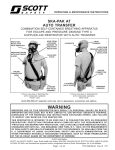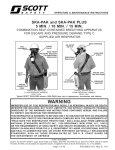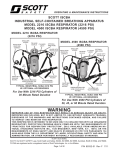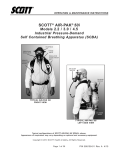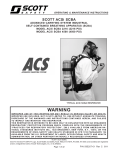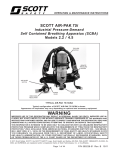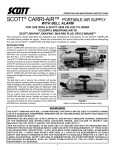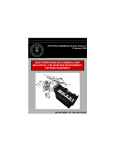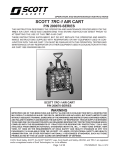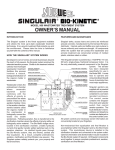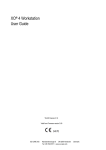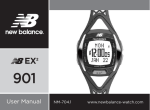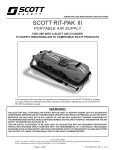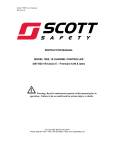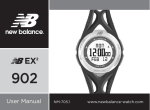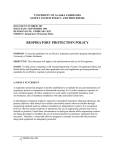Download EZ-Airline Respirator - User Manual
Transcript
OPERATING AND MAINTENANCE INSTRUCTIONS SCOTT E-Z AIRLINE PRESSURE DEMAND TYPE C SUPPLIED AIR RESPIRATOR FOR USE WITH A SCOTT FULL FACEPIECE MASK-MOUNTED BREATHING REGULATOR FACEPIECE HEAD HARNESS AIR-SAVER SWITCH LOOP IN SHOULDER STRAP TO RETAIN REGULATOR HOSE AIR INLET HOSE TO BREATHING REGULATOR SHOULDER STRAP PURGE VALVE WAIST BELT D-RING QUICK DISCONNECT ON AIR SUPPLY HOSE SNAP HOOK AIR SUPPLY HOSE FRONT VIEW FIGURE 1 REAR VIEW SCOTT E-Z AIRLINE TYPE "C" SUPPLIED AIR RESPIRATOR WARNING I M P R O P E R U S E O F T H I S R E S P I R AT O R M AY R E S U LT I N S E R I O U S I N J U RY O R D E AT H . IMPROPER USE INCLUDES, BUT IS NOT LIMITED TO USE WITHOUT ADEQUATE TRAINING, FAILURE TO INSPECT AND MAINTAIN THIS RESPIRATOR, OR DISREGARD OF THE WARNINGS AND INSTRUCTIONS CONTAINED HEREIN. THIS RESPIRATOR IS NOT TO BE USED IN AN OXYGEN DEFICIENT ATMOSPHERE OR IN ATMOSPHERES WHERE THE USER CANNOT SAFELY ESCAPE WITHOUT THE USE OF RESPIRATOR. THIS RESPIRATOR IS NOT TO BE USED IN AN ATMOSPHERE CONTAINING DANGEROUS OR TOXIC SUBSTANCES THAT EXCEED THE MAXIMUM USE CONCENTRATION (MUC) ESTABLISHED BY THE U.S. GOVERNMENT FOR A FULL FACE PRESSURE-DEMAND TYPE "C" RESPIRATOR OR IN ANY ATMOSPHERES THAT ARE OR COULD BECOME IMMEDIATELY HAZARDOUS TO LIFE OR HEALTH (IDLH). THIS RESPIRATOR IS INTENDED TO BE USED ONLY IN CONJUNCTION WITH AN ORGANIZED RESPIRATORY PROTECTION PROGRAM WHICH COMPLIES WITH THE REQUIREMENTS OF ANSI STANDARD Z88.2 1992 "PRACTICES FOR RESPIRATORY PROTECTION," (AVAILABLE FROM AMERICAN NATIONAL STANDARDS INSTITUTE, INC., 11 WEST 42ND STREET, NEW YORK, N.Y. 10036), WITH OSHA SAFETY AND HEALTH STANDARD 29 CFR 1910 PARAGRAPH 134 (AVAILABLE FROM US . DEPARTMENT OF LABOR, OCCUPATIONAL SAFETY AND HEALTH ADMINISTRATION), OR ANY OTHER PERTINENT NATIONALLY RECOGNIZED STANDARDS, SUCH AS THOSE PROMULGATED BY THE U.S. COAST GUARD OR DEPARTMENT OF DEFENSE. © 2011 Scott Safety SCOTT, the SCOTT SAFETY Logo, Scott Health and Safety, E-Z Airline, AV-2000, AV-3000, and SureSeal are registered and/or unregistered marks of Scott Technologies, Inc. or its affiliates. Page 1 of 32 P/N 89310-01 Rev E 7/11 GENERAL DESCRIPTION The SCOTT E-Z AIRLINE respirator is approved by the National Institute for Occupational Safety and Health (NIOSH) as a pressure-demand, open circuit, Type “C” supplied-air respirator. The E-Z AIRLINE Respirator is designed to provide respiratory protection during entry into, work in and egress from atmospheres in which the concentration of objectionable, irritating or hazardous substances does not exceed the maximum use concentration (MUC) established for full face pressure demand Type “C” Respirators by US Government regulation. The E-Z AIRLINE Respirator must never be used in atmospheres which are oxygen deficient or which are considered immediately dangerous to life or health (IDLH). The E-Z AIRLINE may be used only in environments from which the user can safely escape without the use of a respirator. This respirator is to be used only by persons trained in the use of the respirator and only in conjunction with an organized respiratory protection program. The E-Z AIRLINE Respirator is not intended to be used where exposure to high heat and/or flame is possible. This respirator is not to be used under water, for interior structural fire fighting or for any other purpose not authorized by the organized respiratory protection program that applies specifically to the user. All models of the E-Z AIRLINE Respirator must be supplied with breathing air known to be suitable for human respiration at a pressure of 60 psig to 125 psig for operation. The E-Z AIRLINE Respirator consists of four major subassemblies, 1) a full facepiece with head harness, 2) a facepiece mounted pressure demand breathing regulator with air inlet hose, 3) a body harness to prevent the air supply hose from accidentally dislodging the facepiece, and 4) one or more lengths of air supply hose to connect the respirator to a remote breathing air supply. The E-Z AIRLINE Respirator MUST be connected to a supply of breathing air meeting the requirements defined in these instructions. The respirator alone does not offer any protection without a suitable supply of breathing air. The E-Z AIRLINE Respirator is available in three different models with air inlet hoses to fit with popular families of air supply hose fittings. The respirator model must match the air supply hose type to be used. See Table 1 of this document. Each model is also available with a MODULAIR quick disconnect fitting between the regulator and the air inlet hose which permits easy removal of the regulator. The breathing regulator is equipped with an air saver switch to prevent rapid loss of air if the air supply is turned on before donning the facepiece or if the facepiece is removed before disconnecting from or turning off the air supply. The breathing regulator is also equipped with a purge valve which may be used to provide a flow of air into the facepiece for rapid removal of condensed moisture (fog) on the interior of the facepiece or to provide air in the event of a malfunction of the breathing regulator. Because the air supplied to this type of respirator is delivered through an air supply hose from a remote air source, THE BREATHING REGULATOR IS NOT EQUIPPED WITH AN END-OF-SERVICE LIFE INDICATOR OR ALARM. P/N 89310-01 Rev E 7/11 Page 2 of 32 WARNING DO NOT OPERATE THIS EQUIPMENT WHILE UNDER THE INFLUENCE OF DRUGS, ALC O H O L , O R A N Y M E D I C AT I O N S O R SUBSTANCES WHICH MAY AFFECT VISION, DEXTERITY, OR JUDGMENT. USERS OF THIS EQUIPMENT MUST BE IN GOOD PHYSICAL AND MENTAL HEALTH IN ORDER TO OPERATE SAFELY. DO NOT USE THIS EQUIPMENT WHEN FATIGUE PREVENTS SAFE OPERATION. STAY ALERT WHEN OPERATING THIS EQUIPMENT. INATTENTION OR CARELESSNESS WHILE OPERATING THIS EQUIPMENT MAY RESULT IN SERIOUS INJURY OR DEATH. WARNING DO NOT USE THIS RESPIRATOR IN ATMOSPHERES WHICH ARE, OR ARE LIKELY TO BECOME, IMMEDIATELY DANGEROUS TO LIFE OR HEALTH (IDLH). IN SUCH CIRCUMSTANCES, SELECT A DIFFERENT TYPE OF RESPIRATOR SUITABLE TO THE LEVEL OF HAZARD PRESENT OR FORESEEABLE. IMPROPER USE OF THIS RESPIRATOR MAY RESULT IN SERIOUS INJURY OR DEATH. WARNING IF USE OF A HOSE IN THE WORK AREA WILL CREATE A HAZARD, DO NOT USE T H I S R E S P I R ATO R . M A K E W H AT E V E R CHANGES ARE NECESSARY FOR SAFETY, SUCH AS SELECTING AN APPROPRIATE RESPIRATOR. FAILURE TO CONSIDER ALL POSSIBLE CIRCUMSTANCES IN THE USE OF THIS EQUIPMENT MAY RESULT IN SERIOUS INJURY OR DEATH. WARNING CERTAIN ENVIRONMENTS MAY REQUIRE THAT PROTECTIVE MATERIAL COVER SOME OR ALL OF THE RESPIRATOR IN ADDITION TO COVERING THE USER. THE USER MUST BE ABLE TO ACCESS THE RESPIRATOR AT ALL TIMES. INABILITY TO ACCESS THE RESPIRATOR WHEN ATTEMPTING TO ESCAPE A HAZARDOUS SITUATION MAY RESULT IN SERIOUS INJURY OR DEATH. WARNING THE BREATHING REGULATOR IS NOT EQUIPPED WITH AN END-OF-SERVICE LIFE INDICATOR OR ALARM. IF THE AIR SUPPLY FAILS AT ANY TIME, IMMEDIATELY LEAVE THE AREA REQUIRING RESPIRATORY PROTECTION. FAILURE TO IMMEDIATELY EXIT THE HAZARDOUS ATMOSPHERE WHEN THE AIR SUPPLY FAILS MAY RESULT IN SERIOUS INJURY OR DEATH. SCOTT Full Facepieces are available in several approved models and sizes suitable for a variety of applications. The facepieces may be readily detached from the breathing regulator to allow for use of the best fitting and most comfortable size facepiece for an individual user. Fit testing per OSHA Standard 29 CFR Part 1910 or ANSI Standard Z88.2 requires testing in the negative pressure mode using equipment such as a Portacount Plus 1 Respirator Fit Tester. For this, SCOTT facepieces require use of SCOTT Fit Test Adapter P/N 804057-01 or equivalent and appropriate negative pressure testing equipment. Mask Seal Kit P/N 805655-01 may also be required to attain a proper fit. Fit testing is required as part of the respirator use training to determine the correct model and size SCOTT Full Facepiece will fit each individual user. Each size facepiece may be equipped with a lens kit if the use of corrective spectacles is required. See ACCESSORIES section at the end of this document. Some facepiece models incorporate a standard nose cup with two inhalation check valves. The nose cup is required for use of the respirator in temperatures below freezing (32 °F / 0 °C). A nose cup can be added to certain facepieces when required. See the LOW TEMPERATURE OPERATION section of this instruction for details. The facepiece is equipped with D-Rings to suspend the facepiece from the neck using a SCOTT Neck Strap Assembly accessory when the respirator is being worn in the “stand-by” position, ready for use but the facepiece is not donned. Three types of head harnesses are available for use with the facepiece. The rubber head harness is designed to facilitate easy cleaning. The black polyester head harness is highly resistant to corrosives. However, polyester may soften and melt if exposed to temperatures exceeding 300 °F / 150 °C, and, if exposed to flame, polyester may burn. The yellow Kevlar 2 head harnesses are constructed of a heat resistant fabric. The body harness consists of a waist belt with D-Rings to connect to a shoulder strap. A strain relief snap hook on the end of the air inlet hose of the breathing regulator snaps onto one of the D-Rings to transfer the weight of the air supply hose to the body harness to prevent air supply hose from pulling on the facepiece. The body harness is made of black polypropylene webbing and metallic buckles. The polypropylene webbing will soften at temperatures approaching 300° F / 150° C. At higher temperatures, the material may melt and, if exposed to flame, polypropylene may burn. Air supply hoses used to connect the E-Z AIRLINE Respirator to a remote breathing air supply system are available with several popular fittings and in several lengths. The maximum length and maximum number of segments of air supply hose allowed varies with the chosen family of fittings. The air supply hoses and their limitations are covered in Table 1 and Table 2 of this instruction sheet. WARNING RESPIRATORS SHALL NOT BE WORN WHEN CONDITIONS PREVENT A GOOD FACE SEAL. SUCH CONDITIONS MAY INCLUDE, BUT ARE NOT LIMITED TO, GROWTH OF BEARDS, SIDEBURNS, A SKULL CAP THAT PROJECTS UNDER THE FACEPIECE OR TEMPLE PIECES ON EYEGLASSES. ALSO, ABSENCE OF ONE OR BOTH DENTURES CAN SERIOUSLY AFFECT THE FIT OF A FACEPIECE. ANY CONDITION WHICH PREVENTS A GOOD FACE SEAL MAY PERMIT EXPOSURE TO THE HAZARDOUS ATMOSPHERE WHICH MAY RESULT IN SERIOUS INJURY OR DEATH. WARNING DO NOT USE THE BLACK POLYESTER H E A D H A R N E S S OR POLYPROPYLENE BODY HARNESS WHEN ACCIDENTAL EXPOSURE TO HIGH HEAT OR FLAME IS A POSSIBILITY. IN THOSE CIRCUMSTANCES, THE POLYESTER OR POLYPROPYLENE MAY MELT OR BURN CAUSING INJURY OR MAY INTERFERE WITH RESPIRATORY PROTECTION RESULTING IN SERIOUS INJURY OR DEATH. WARNING USE OF THIS RESPIRATOR WITHOUT ATTACHING THE STRAIN RELIEF CLIP TO THE WAIST BELT MAY ALLOW THE AIR SUPPLY HOSE TO PULL AT AND DISLODGE THE FACEPIECE EXPOSING THE USER TO THE HAZARDOUS ATMOSPHERE WHICH MAY RESULT IN SERIOUS INJURY OR DEATH. WARNING DO NOT USE OTHER HOSES, COUPLINGS OR ADAPTERS TO ATTACH INCOMPATIBLE COMPONENTS TO THE RESPIRATOR. USE OF HOSES OTHER THAN THOSE SPECIFIED MAY REDUCE THE ABILITY OF THE RESPIRATOR TO SUPPLY AIR AND MAY EXPOSE THE USER TO THE ATMOSPHERE THE RESPIRATOR WAS DESIGNED TO PROTECT AGAINST RESULTING IN SERIOUS INJURY OR DEATH. 1 2 Portacount Plus is a registered trademark of TSI Incorporated Kevlar is a registered trademark of E.I. du Pont de Nemours, Inc. Page 3 of 32 P/N 89310-01 Rev E 7/11 FACEPIECE FITTING AND FIT TESTING A respirator Quantitative Fit Test must be performed to ensure the correct respirator facepiece size has been selected and assigned to the user. It is the responsibility of the Respiratory Protection Program Manager or Safety Coordinator to assist the user in selecting the correct respirator size relative to the user’s facial features and dimensions. Fit Testing must be performed with any approved SCOTT accessories that will be used with the respirator installed, such as a communications device installed on the facepiece. Respirator fit tests are explained fully in the American National Standard Practices for Respiratory Protection, ANSI Z88.10-2001 which is published by the American National Standards Institute (ANSI), 11 West 42nd Street, New York, New York, 10036, and in the Occupational Safety and Health Standards, OSHA 29 CFR 1910.134 Appendix A, which is published by the Occupational Safety and Health Administration (OSHA), 200 Constitution Avenue, NW, Washington DC, 20210. Quantitative Fit Testing per OSHA Standard 29 CFR Part 1910.134 Appendix A, or ANSI Standard Z88.10-2001 requires testing in the negative pressure mode using equipment such as a Portacount Respirator Fit Tester. For Quantitative Fit Testing, SCOTT facepieces require use of the appropriate negative pressure testing equipment such as the Portacount Respirator Fit Tester along with the following: • SCOTT 40mm facepiece Adapter, P/N 200423-01, • a new SCOTT P100 Cartridge, P/N 052683, • SCOTT Probed Fit Test Adapter P/N 805628-01 or equivalent probed facepieces and the full range of sizes and styles • Mask Seal Kit, P/N 805655-01 • the appropriate SCOTT communication device and mounting bracket properly installed on the facepiece, if such an accessory will be used with the respirator. • any other optional hood, eyeglass, or other accessory that will be used with the respirator. The size and style facepiece must be selected based on the user’s measured face size. For initial fitting, carefully don the facepiece and conduct a NEGATIVE PRESSURE LEAK TEST according to the instructions provided with the 40mm Adapter. Refer to the DONNING PROCEDURE section of this instruction for the procedure. Follow the DONNING PROCEDURE CAREFULLY. If the selected facepiece does not pass the NEGATIVE PRESSURE LEAK TEST or does not fit securely without movement in the chin or chin cup area or the user experiences discomfort in the chin or throat, try the next nearest size, larger or smaller. After passing the NEGATIVE PRESSURE LEAK TEST, the facepiece size selected must be verified by successfully passing a respirator Quantitative Fit Test. When fit testing for Type C Pressure-Demand Supplied Air Respirator mode of operation (minimum Fit Factor equal to or greater than 500 minimum) appropriate negative pressure testing equipment must be used. You should use a P100 Filter, SCOTT P/N 052683 and the SCOTT P/N 805628-01 Fit Test Adapter. When using a Portacount Respirator Fit Tester for Quantitative Fit Testing, TSI recommends that the level of particles in the ambient air must be between 5000 and 30000 particles/cm3. Refer to the Portacount Respirator Fit Tester user instructions for details including available Particle Generators to use with the Portacount Respirator Fit Tester if you have difficulty achieving the minimum level of ambient particle count required. Test subjects must be in good health at the time of the fit testing. Smoking or eating less than 30 minutes prior to the test is prohibited. Any and all conditions that might interfere with a good face to facepiece seal must be addressed and corrected before performing the fit testing. Refer to the list of conditions in the DONNING PROCEDURES section of this instruction. P/N 89310-01 Rev E 7/11 Page 4 of 32 WARNING THE USER MUST BE PROPERLY FITTED USING A RESPIRATOR QUANTITATIVE FIT TEST BEFORE USE AND FOLLOW ALL WARNINGS AND SPECIAL OR CRITICAL USER’S INSTRUCTIONS SPECIFIED DURING USE. FAILURE TO DO SO MAY RESULT IN SERIOUS INJURY OR DEATH. WARNING FIT TESTING IN ACCORDANCE WITH OSHA STANDARD 29 CFR PART 1910 IS REQUIRED AS PART OF THE REQUIRED TRAINING BEFORE USE OF THIS RESPIRATOR. FAILURE TO PROPERLY FIT AND TRAIN THE USER IN USE OF THE FACEPIECE AND RESPIRATOR MAY RESULT IN EXPOSURE TO THE HAZARDOUS ATMOSPHERE WHICH COULD LEAD TO SERIOUS INJURY OR DEATH. WARNING RESPIRATORS SHALL NOT BE WORN WHEN C O N D I T I O N S P R E V E N T A GOOD FA C E SEAL. SUCH CONDITIONS MAY INCLUDE, BUT ARE NOT LIMITED TO, GROWTH OF BEARDS, SIDEBURNS, FACIAL HAIR OR LOW HAIRLINE THAT CROSSES OR INTERFERES WITH THE SEALING SURFACE, THICK OR PROTRUDING HAIRSTYLES SUCH AS PONY TAILS OR BUNS THAT INTERFERE WITH THE SMOOTH AND CLOSE FIT OF THE HEAD HARNESS TO THE HEAD, A SKULL CAP THAT PROJECTS UNDER THE FACEPIECE, TEMPLE PIECES ON CORRECTIVE EYE GLASSES, EXCESSIVE USE OF COSMETICS INCLUDING MOISTURIZERS, MAKE-UP, OR AFTER SHAVE, OR ANYTHING ELSE WHICH INTERFERES WITH THE FACE TO FACEPIECE SEAL. ALSO, THE ABSENCE OF ONE OR BOTH DENTURES CAN SERIOUSLY AFFECT THE FIT OF A FACEPIECE. USE OF AN IMPROPERLY FITTED FACEPIECE MAY LEAD TO EXPOSURE TO THE HAZARDOUS ATMOSPHERE WHICH COULD RESULT IN SERIOUS INJURY OR DEATH. To verify the fit factor of the respirator, testing must incorporate an exercise regimen of normal daily activities. SCOTT requires the following set of fit test exercises, which are based on OSHA Standard 29 CFR Part 1910.134 Appendix A, and ANSI Z88.10-2001 with modifications. Exercises are to be performed each for 60 seconds (except as noted) in a standing position during the test: • Normal Breathing • Deep breathing • Turning head side to side • Moving head up and down (look up/look down) • Talking (read the Rainbow Passage) • Grimace (15 seconds) • Bending Over (touch toes) / Reach up (toward the ceiling) • Normal Breathing (repeat) Fit test exercises must be performed carefully as if the respirator was being used in a hazardous atmosphere. DO NOT bump the facepiece, filter, or adapter into the body through exaggerated motions. DO NOT talk except when directed to by the test administrator. SCOTT requires that users of this respirator with an approved SCOTT facepiece, must achieve a Fit Factor of at least 500 for Type C Pressure-Demand Supplied Air Respirator mode of operation for use with their assigned facepiece style and size using the fit test procedures and exercise regimen stated above. If a Fit Factor of at least 500 cannot be achieved with any facepiece size or style, the user MUST NOT use this respirator. If the respirator user passes a NEGATIVE PRESSURE LEAK TEST but DOES NOT pass a respirator Quantitative Fit Test, try the next nearest size, larger or smaller and repeat the NEGATIVE PRESSURE LEAK TEST and the Quantitative Fit Test. If leakage is still detected, either per these user instructions or the OSHA fit testing process, the use of Mask Seal Kit P/N 805655-01 may be required to attain a proper fit. Refer to the INSTALLATION AND USE INSTRUCTIONS, SCOTT P/N 89462-01, included with the Mask Seal Kit. After installing the Mask Seal Kit, repeat the fit testing process to confirm a proper fit. During NEGATIVE PRESSURE LEAK TESTING, any facepiece leakage that is detected from other than the face to facepiece seal may indicate damaged or defective equipment. Remove the defective equipment from service and tag for repair by authorized personnel. Repeat the testing with equipment known to be operating properly. Once the proper size is selected and assigned to the user following successful Portacount Respirator Fit Tester testing to achieve minimum Fit Factors required, the respirator user must use the assigned facepiece size and style every time the respirator is used to ensure proper fit. The facepiece alone does not provide any protection against a hazardous atmosphere without the use of the complete E-Z Airline Respirator and a suitable supply of breathing air. A respirator Quantitative Fit Test must be routinely carried out as outlined above for each user of this respirator to determine or confirm the amount of protection that the respirator provides. Periodically repeating the fit testing is required to identify any physical changes of the user (such as those listed in the DONNING PROCEDURES) which could effect the fit of the facepiece. Page 5 of 32 P/N 89310-01 Rev E 7/11 CHOOSING THE APPROPRIATE EQUIPMENT Respirators reduce but do not eliminate all exposure to the hazardous atmosphere. Some facepiece/respirator combinations are more effective than others at reducing exposure depending on the nature and the concentration of the contaminant in the hazardous atmosphere. When choosing a respirator and facepiece, the respiratory protection program under which this respirator is to be used must determine the appropriate level of protection that the facepiece/respirator is expected to provide. Use of inappropriate RESPIRATOR equipment for the work environment may result in exposure to the hazardous atmosphere which may cause serious injury or death. The respiratory protection program must also take into consideration the levels of exposure which may be hazardous irrespective of respiratory protection (e.g.: contaminants which are toxic through exposure to unprotected skin). Additional protective equipment such as apparel may be required. However, any additional protective equipment must not interfere with access to or operation of the respirator. When properly donned and operated, the SCOTT E-Z Airline respirator provides limited protection from airborne contaminants to only the respiratory system and part of the face of the user. The using agency must provide the appropriate protective clothing for use with the E-Z Airline respirator and must insure that protective clothing does not interfere with the operation of the E-Z Airline respirator, NIOSH approval is granted to respiratory protection equipment made up of specific combinations of parts or assemblies that have been successfully tested to the performance standards established by the approval agencies. To maintain NIOSH approval, an AV-3000 facepiece equipped with a SureSeal face seal P/N 31001738 (Small), P/N 31001739 (Medium), or P/N 31001740 (Large) must be used only with Grey Nose Cup P/N 31001043 (Small), P/N 31001044 (Medium), or P/N 31001045 (Large). If you are using an AV-3000 facepiece equipped with a SureSeal face seal and do not have a Grey Nose Cup, contact SCOTT or your authorized SCOTT distributor. Failure to comply with this requirement will void the approvals for your respirator. Use of a non-approved configuration in a hazardous atmosphere may result in serious injury or death. QUESTIONS OR CONCERNS If you have any questions or concerns regarding use of this equipment, contact your authorized SCOTT distributor, or contact SCOTT at 1-800-247-7257 (or 704-291-8300 outside the continental United States). EXPORT AND IMPORT The international transport of this equipment is regulated under United States export regulations and may be regulated by the import regulations of other countries. If you have any questions or concerns regarding these regulations, contact SCOTT at 1-800-247-7257 (or 704-291-8300 outside the continental United States). P/N 89310-01 Rev E 7/11 Page 6 of 32 WARNING THE RESPIRATORY PROTECTION PROGRAM UNDER WHICH THIS EQUIPMENT IS TO BE USED MUST DETERMINE THE APPROPRIATE LEVEL OF PROTECTION THAT THE RESPIRATOR IS EXPECTED TO PROVIDE. USE OF INAPPROPRIATE RESPIRATOR EQUIPMENT FOR THE WORK ENVIRONMENT MAY RESULT IN EXPOSURE TO THE HAZARDOUS ATMOSPHERE WHICH MAY CAUSE SERIOUS INJURY OR DEATH. WARNING THIS RESPIRATOR PROVIDES PROTECTION ONLY TO THE USER’S RESPIRATORY SYSTEM AND TO PART OF THE FACE. IF THE HAZARDOUS ATMOSPHERE CONTAINS TOXINS OR CONTAMINANTS WHICH MAY POISON THROUGH THE SKIN, ADDITIONAL PROTECTIVE EQUIPMENT MAY BE RE QUIRED. FAILURE TO PROVIDE ADEQUATE PROTECTIVE EQUIPMENT FOR THE HAZARDS IN THE WORKPLACE MAY RESULT IN SERIOUS INJURY OR DEATH. WARNING TO MAINTAIN NIOSH APPROVAL, AN AV-3000 FACEPIECE EQUIPPED WITH A SURESEAL FACE SEAL P/N 31001738 (SMALL), P/N 31001739 (MEDIUM), OR P/N 31001740 ( L A R G E ) M U S T B E U S E D O N LY W I T H GREY NOSE CUP P/N 31001043 (SMALL), P/N 31001044 (MEDIUM), OR P/N 31001045 (LARGE). USE OF A NON-APPROVED CONFIGURATION IN A HAZARDOUS ATMOSPHERE MAY RESULT IN SERIOUS INJURY OR DEATH. AIR SUPPLY SYSTEM REQUIREMENTS IT IS THE RESPONSIBILITY OF THE ORGANIZED RESPIRATORY PROGRAM UNDER WHICH THE RESPIRATOR IS USED TO PROVIDE A SUPPLY OF AIR THAT IS KNOWN TO BE CLEAN AND SAFE FOR BREATHING AND TO ENSURE THAT THE BREATHING AIR SUPPLY SYSTEM MEETS ALL OTHER REQUIREMENTS STATED BELOW. The E-Z AIRLINE Type “C” supplied-air respirator must be connected to a suitable supply of clean breathing air through one or more segments of air supply hose. The air supply system must supply air containing no less than 19.5 percent oxygen and meeting the Grade “D” requirements of the Compressed Gas Association (CGA) Commodity Specification for Air. Copies of this specification are available from the CGA, Inc. (703-413-4341), 1725 Jefferson Davis Highway, Arlington, Virginia 22202. In addition, the air must be dry, TO A DEW POINT OF -65 °F / -54 °C OR LOWER. If the breathing air is not dry, water may condense on the inside of the air supply lines or inside the respirator. In temperatures at or below freezing (+32 °F /0 °C), the condensation may freeze inside the air supply lines or inside the respirator, possibly causing the flow of breathing air to be reduced or to stop completely. The user’s breathing air volume requirement will vary depending on the activity being performed. The volume of air needed, expressed in liters per minute (lpm) at 1 atmosphere pressure, may range from less than 20 lpm when at rest to over 60 lpm during heavy work. The air supply system must be capable of maintaining the air pressure at the point of attachment of the supply hose to the air supply system at no less than 60 psig and no more than 125 psig while meeting the user’s air volume requirement. The air supply system must be equipped with a pressure-release mechanism that will prevent the pressure at the point of attachment of the hose to the air supply system from exceeding 125 psig. If the respirator is connected to an air supply system with the facepiece not donned and the air-saver switch on the facepiece mounted regulator has not been depressed, air will flow freely from the facepiece. Depending on the type and length of air supply hose used, the airflow may be in excess of 400 lpm. Depressing the air-saver switch on top of the facepiece mounted regulator will stop this flow of air. WARNING USE ONLY BREATHING AIR WHICH MEETS THE REQUIREMENTS AS DESCRIBED IN THE AIR SUPPLY REQUIREMENTS SECTION OF THIS INSTRUCTION (CONTAINING NO LESS THAN 19.5% OXYGEN AND MEETING CGA G-7.1 GRADE "D" OR BETTER). USE OF AN AIR SUPPLY THAT DOES NOT MEET THE REQUIREMENTS COULD RESULT IN SERIOUS INJURY OR DEATH. WARNING USE ONLY BREATHING AIR KNOWN TO BE SUITABLE FOR HUMAN RESPIRATION. THE USE OF "TOOL AIR," "INSTRUMENT AIR," OR ANY AIR SUPPLY NOT SPECIFICALLY INTENDED FOR HUMAN BREATHING MAY CONTAIN CONTAMINANTS WHICH MAY CAUSE SERIOUS INJURY OR DEATH. WARNING DO NOT USE OXYGEN! USE OF THIS RESPIRATOR IS ONLY APPROVED WITH THE PROPER GRADE OF BREATHING AIR. SUPPLYING THE RESPIRATOR WITH OXYGEN MAY CAUSE SICKNESS OR MAY CAUSE A FIRE OR EXPLOSION RESULTING IN SERIOUS INJURY OR DEATH. WARNING USE ONLY AIR DRIED TO A DEW POINT OF -65° F / -54° C OR LESS. MOISTURE IN AIR UNDER PRESSURE CAN FREEZE EVEN AT AMBIENT TEMPERATURES WELL ABOVE +32° F / 0° C. FAILURE TO ENSURE THE AIR SUPPLY IS FREE OF CONDENSED MOISTURE MAY CAUSE FREEZING AND PARTIAL OR COMPLETE FAILURE OF THE RESPIRATOR LEADING TO SERIOUS INJURY OR DEATH. WARNING THE BREATHING AIR SUPPLY SYSTEM MUST BE CAPABLE OF SUPPLYING THE REQUIRED PRESSURE OF 60 TO 125 PSIG. FAILURE TO MAINTAIN THE REQUIRED AIR SUPPLY PRESSURE MAY REDUCE THE PROTECTION CAPABILITY OF THE RESPIRATOR AND EXPOSE THE USER TO THE ATMOSPHERE THE RESPIRATOR WAS DESIGNED TO PROTECT AGAINST RESULTING INS SERIOUS INJURY OR DEATH. WARNING FAILURE TO DEPRESS THE AIR SAVER/ DONNING SWITCH WHEN THE RESPIRATOR IN NOT IN USE WILL RESULT IN A FREE FLOW OF AIR FROM THE RESPIRATOR WHICH MAY AFFECT THE AIR SUPPLY SYSTEM PRESSURE AND/OR VOLUME TO OTHER RESPIRATOR USERS ON THE SAME SUPPLY SYSTEM AND CAUSE SERIOUS INJURY OR DEATH. AIR SUPPLY SYSTEM REQUIREMENTS CONTINUED ON NEXT PAGE... Page 7 of 32 P/N 89310-01 Rev E 7/11 AIR SUPPLY SYSTEM REQUIREMENTS CONTINUED... Because the performance of a supplied air respirator is dependent upon the characteristics of the air supply hose used, the E-Z AIRLINE respirator is NIOSH certified only when used with one of the types of hose it has been tested and approved with. The types of hose are: • SCOTT 30010-Series air supply hose • SCOTT 26370-Series air supply hose • SCOTT 200820-Series air supply hose • SCOTT 803904-01 air supply hose. • SCOTT 30020-Series air supply hose and • SCOTT 26369-Series air supply hose The 30010-Series, 26370-Series, 200820-Series, and 803904-01 air supply hoses may be interchanged to supply a single E-Z AIRLINE respirator, and, except for these, different types of supply hose may NOT be mixed. The 30010 series hose utilizes Hansen 3 brass disconnect couplings. The 26370-Series hose utilizes stainless steel Foster 4 disconnect couplings. The 200820-Series hose utilizes a stainless steel Foster male disconnect coupling and a brass Foster female disconnect coupling. The 26369 series hose utilizes stainless steel Hansen HK disconnect couplings. The 30020 series hose utilizes steel Schrader 5 disconnect couplings. One of these types of couplings is located on the end of the airline connection hose and at the ends of each segment of air supply hose. The air supply hose segments must be directly coupled to the airline connection hose at the waist belt of the respirator, to each other and to the air supply system. Adapters shall not be used. SCOTT part numbers are stamped on all assemblies to facilitate identification. Use Table 1 on Page 7 of this instruction sheet to determine the manufacturer and series number of the couplings that are compatible with your E-Z AIRLINE Respirator. The correct coupling must be installed directly on the air supply system and must match both the couplings installed on the air supply hose(s) and the coupling installed on the E-Z AIRLINE connection hose. Adapters shall not be used. The couplings and fittings that mate with the couplings used on SCOTT air supply hose are available from SCOTT or from the coupling manufacturer. Use FIGURE 3 on page 8 to determine what couplings are required. After determining which type of air supply hose and couplings are used with your respirator, locate the appropriate section of Table 2 of this instruction sheet for detailed instructions on operating the coupling and for limitations on air supply hose length and number of segments allowed. DURATION OF THE RESPIRATOR The respirator is rated and approved by NIOSH as a pressure demand Type “C” supplied-air respirator. The duration of this respirator is limited only by the capacity of the air-supply system. 3 4 5 Hansen is a registered trademark of Tuthill Corporation. Foster is a registered trademark of Foster Manufacturing Co., Inc. Schrader is a registered trademark of Scovill, Inc. P/N 89310-01 Rev E 7/11 Page 8 of 32 WARNING DO NOT USE OTHER HOSES, COUPLINGS OR ADAPTERS TO ATTACH INCOMPATIBLE COMPONENTS TO THE RESPIRATOR. USE OF HOSES OTHER THAN THOSE SPECIFIED MAY REDUCE THE ABILITY OF THE RESPIRATOR TO SUPPLY AIR AND MAY EXPOSE THE USER TO THE ATMOSPHERE THE RESPIRATOR WAS DESIGNED TO PROTECT AGAINST RESULTING IN SERIOUS INJURY OR DEATH. WARNING ALL RESPIRATOR USERS MUST BE FULLY TRAINED IN THE PROCEDURE FOR DISCONNECTING THE COUPLING OF THE SUPPLY HOSE BEING USED. FAILURE TO ADEQUATELY TRAIN USERS MAY INTERFERE WITH AN EMERGENCY ESCAPE AND RESULT IN SERIOUS INJURY OR DEATH. TABLE 1 IDENTIFICATION OF SUPPLY HOSE AND SUPPLY HOSE COUPLINGS SCOTT Mask Mounted Regulator Assembly 6 Corresponding SCOTT Supply Hose Required 7 Type of coupling required from coupling manufacturer for connection to air supply system SEE WARNING BELOW Air Supply Couplings Available from SCOTT P/N 804441-01 or 804441-05 8 w/ 804694-04 9 30010-SERIES, 26370-SERIES, 200820-SERIES or 803904-01 Hansen 3000 Series 10 or Foster 3 Series manual P/N 19458-00 11 P/N 19889-00 7 P/N 804441-02 or 804441-05 8 w/ 804694-03 9 30020-SERIES Schrader Standard Twist Lock P/N 6831-00 11 P/N 55065-00 12 P/N 804441-03 or 804441-05 8 w/ 804694-02 9 25369-SERIES Hansen 2HK Series 10 P/N 10008005 12 SCOTT Part Number (P/N) stamped into end of hose. SCOTT Part Number (P/N) stamped into hose within 6 inches of either end. 8 Regulator equipped with quick disconnect. 9 Hose from quick disconnect to disconnect for supply hose 10 Specify silicone seals if ordering couplings from the manufacturer. 11 Female connector with 1/4 inch male NPT inlet fitting. 12 Female connector with 1/4 inch female NPT inlet fitting. 6 7 WARNING THE ABOVE INFORMATION IS SUPPLIED TO ASSIST IN INSTALLING A SUITABLE REMOTE AIR SUPPLY SYSTEM. DO NOT ATTEMPT TO CHANGE ANY FITTINGS ON THE RESPIRATOR OR RESPIRATOR SUPPLY HOSE. FAILURE TO PROVIDE A SUITABLE SUPPLY OF CLEAN AND SAFE BREATHING AIR MEETING AT LEAST THE REQUIREMENTS SET FORTH IN THE AIR SUPPLY SYSTEM REQUIREMENTS SECTION ABOVE AND/OR THE USE OF FITTINGS, CONNECTIONS OR ADAPTERS NOT SUPPLIED BY SCOTT OR AS DIRECTED ABOVE MAY VOID THE WARRANTY, VOID NIOSH CERTIFICATION AND MAY ADVERSELY EFFECT RESPIRATOR PERFORMANCE AND ENDANGER THE RESPIRATOR USER RESULTING IN SERIOUS INJURY OR DEATH. E-Z AIRLINE RESPIRATOR REMOTE AIR SUPPLY SYSTEM REMOTE AIR SUPPLY GAUGE ATTACH SNAP HOOK ON END OF BREATHING AIR INLET HOSE TO "D" RING OF BODY HARNESS HERE REMOTE AIR SUPPLY VALVE AIR SUPPLY HOSE DISCONNECT SUPPLY HOSE RESPIRATOR HERE REMOTE AIR SUPPLY SOURCE REMOTE AIR SUPPLY REGULATING AIR BETWEEN 60 AND 125 PSIG PRESSURE RELIEF MECHANISM TO LIMIT PRESSURE IN HOSE LINE TO 125 PSIG HOSE COUPLINGS AIR SUPPLY SYSTEM COUPLING COMPATIBLE WITH SUPPLY HOSE FIGURE 2 E-Z AIRLINE RESPIRATOR DIAGRAM Page 9 of 32 P/N 89310-01 Rev E 7/11 WARNING THE USER OF THIS RESPIRATOR MAY HAVE TO DISCONNECT THE HOSE COUPLING SUDDENLY AND UNDER STRESSFUL CONDITIONS. THE USER MUST BE ABLE TO DISCONNECT THE COUPLING UNDER THE CONDITIONS WHICH MAY BE ENCOUNTERED DURING USE, FOR EXAMPLE, WITHOUT BEING ABLE TO SEE THE COUPLING, WITH GLOVES ON, WITH ONE HAND, ETC. FAILURE TO ADEQUATELY TRAIN THE USER MAY RESULT IN SERIOUS INJURY OR DEATH. TABLE 2 LIMITATIONS AND OPERATING INSTRUCTIONS FOR SUPPLY HOSE NOTE: THE AIR SUPPLY PRESSURE MUST BE MAINTAINED BETWEEN 60 PSIG AND 125 PSIG WHILE FLOWING AT LEAST 200 LITERS PER MINUTE (LPM) TO EACH USER. Maximum Number of Segments Approved To Achieve Total Length 15 Approved Total Length 14 (in feet) Supply Hose 13 26369-Series with stainless steel Hansen HK couplings 26370-Series or 200820-Series, or 803904-01 Hose with stainless steel Foster couplings 30010-Series with brass Hansen couplings 30020-Series with steel Schrader couplings 0 to 150 6 0 to 300 12 0 to 300 12 0 to 300 INSTRUCTIONS FOR OPERATION OF COUPLINGS Note: The user shall practice and be able to disconnect the couplings quickly in an emergency situation. 1. To connect the coupling, rotate socket sleeve "B" until the alignment notch in the sleeve is in line with alignment peg in body "A". 2. Slide sleeve "B" toward the supply hose (away from plug "C") and insert plug "C" into socket "A". Release sleeve "B" while pushing the plug into the socket until engaged, as evidenced by a "click". Test for positive engagement by tugging on the plug. 3. Rotate sleeve "B" one-quarter to one-half turn to lock the plug against accidental release. 4. To disconnect the coupling, realign sleeve "B" with the body of socket "A" as described in step 1. Slide sleeve "B" away from the body (toward the supply hose) to release the plug fitting from the socket. IF IT IS NOT PRACTICAL TO SEE THE ALIGNMENT NOTCH IN THE SLEEVE, USE THE FOLLOWING PROCEDURE TO DISCONNECT THE COUPLING: 1. Grasp sleeve "B" with the right hand. 2. Simultaneously rotate and push the sleeve away from the plug until the alignment notch in the sleeve lines up with the alignment peg in the body and the socket separates from the plug. 1. Insert plug fitting "C" into socket "A" and continue pushing until it is engaged as evidenced by a "click". 2. Test for positive engagement by tugging on the plug. 3. Disconnect the coupling by rotating sleeve "B" 1/8 turn in the clockwise direction as viewed from the female end of socket "A". 12 The female connectors on all supply hose series are checked to stop the flow of air when they are disconnected. Both male and female connectors are checked on 26369-Series supply hose. 14 "0" feet = direct connection to air supply source. 15 Segments of supply hose are commonly available in 25 ft, 50 ft, 75 ft, and 100 ft length segments. 13 A B C A HANSEN HK COUPLING USED ON 26369 SERIES B C A FOSTER COUPLING USED ON 26370 SERIES B C HANSEN COUPLING USED ON 30010-Series FIGURE 3 COUPLINGS USED ON SUPPLY HOSES P/N 89310-01 Rev E 7/11 Page 10 of 32 A B C SCHRADER COUPLING USED ON 30020 SERIES REGULAR OPERATIONAL INSPECTION The following procedure shall be used when you first receive the respirator and for daily or before use inspection of the respirator. All respirators shall be inspected after each use. If damage or discrepancies are noted during the inspection of the respirator, remove the respirator from service and tag for repair by authorized personnel. DO NOT replace components or make adjustments or repairs to the E-Z AIRLINE respirator beyond the scope of this instruction manual without proper training. WARNING THE INFORMATION BELOW IS MEANT TO SUPPLEMENT, NOT REPLACE, THE INSTRUCTIONS, TRAINING, SUPERVISION, MAINTENANCE AND OTHER ELEMENTS OF YOUR ORGANIZED RESPIRATORY PROTECTION PROGRAM. SEE WARNING ON FIRST PAGE OF THIS DOCUMENT. INSPECTION OF THE RESPIRATOR 1. Visually inspect the respirator for completeness. See FIGURE 1. 2. Inspect the equipment for worn or aging rubber parts which exhibit cracking, splitting, or brittleness. 3. Inspect the body harness for worn or frayed webbing or damaged buckles. Make sure that the waist belt and shoulder strap are assembled properly as shown in FIGURE 1. Adjust the waist and shoulder straps to approximately the full out position. 4. Inspect the air inlet hose assembly that connects the air supply hose to the breathing regulator. Be sure that the hose is undamaged. Be certain the strain relief clip is present and in good working condition, see FIGURE 4. MASK-MOUNTED BREATHING REGULATOR WARNING FOLLOW THE REGULAR OPERATIONAL INSPECTION PROCEDURE EXACTLY. IF THE PURGE DOES NOT ACTUATE AS DESCRIBED IN THIS INSTRUCTION OR ANY OTHER OPERATIONAL MALFUNCTION IS NOTED, DO NOT USE THE RESPIRATOR. REMOVE THE RESPIRATOR FROM SERVICE AND TAG IT FOR REPAIR BY AUTHORIZED PERSONNEL. F A I L U R E T O P R O P E R L Y IDENTIFY MALFUNCTIONS MAY RESULT IN SERIOUS INJURY OR DEATH. AIR-SAVER SWITCH WARNING OPTIONAL MODULAIR QUICK DISCONNECT PURGE VALVE STRAIN RELIEF SNAP HOOK AIR INLET HOSE TO BREATHING REGULATOR FIGURE 4 5. The regulator is retained by the facepiece with a 1/4 turn port and is locked in the facepiece retainer with a lock tab. If the regulator is attached to the facepiece, detach the regulator from the facepiece. Place your right hand over the cover with your thumb on the lock tab. Pull the lock tab toward the cover and rotate the regulator 1/4 turn clockwise (as viewed from inside of facepiece). When the red purge valve is in the 12 o’clock position remove regulator from the facepiece. 6. Inspect the breathing regulator for exterior damage. Verify that the regulator gasket is not damaged and is in place around the outlet port of the regulator. 7. To reconnect the regulator to the facepiece, position the red purge valve in the 12 o’clock position, align the two flats of the outlet port with corresponding flats in the facepiece port, and insert. Rotate the regulator counterclockwise (viewed from inside of facepiece) so that the red purge valve knob is positioned on the left side of the facepiece. The lock tab on the mask-mounted regulator will lock into the facepiece retainer with a “click.” If properly engaged, the regulator will not rotate. THE AIRLINE CONNECTION MUST BE CLEAN. DIRT OR FOREIGN MATERIAL IN THE AIR PASSAGE OF THE AIRLINE CONNECTION PLUG MAY CAUSE PARTIAL OR COMPLETE FAILURE OF THE RESPIRATOR RESULTING IN SERIOUS INJURY OR DEATH. WARNING USE OF THIS RESPIRATOR WITHOUT ATTACHING THE STRAIN RELIEF CLIP TO THE WAIST BELT MAY ALLOW THE AIR SUPPLY HOSE TO PULL AT AND DISLODGE THE FACEPIECE EXPOSING THE USER TO THE HAZARDOUS ATMOSPHERE WHICH MAY RESULT IN SERIOUS INJURY OR DEATH. REGULAR OPERATIONAL INSPECTION CONTINUED ON NEXT PAGE... Page 11 of 32 P/N 89310-01 Rev E 7/11 REGULAR OPERATIONAL INSPECTION CONTINUED... 8. If the breathing regulator is equipped with a MODULAIR quick disconnect, check that the disconnect is operating properly. To remove the quick disconnect, push in on the male plug while pulling back on the outer sleeve of the female coupling. To reattach, insert the male plug into the female coupling and push until engaged as indicated by the sleeve moving forward with a sharp “click.” Test for proper engagement by tugging on the coupling. See FIGURE 5. PUSH PLUG IN PLUG PULL SLEEVE BACK SLEEVE FIGURE 5 9. Inspect the air supply hose segments for cuts and signs of contamination. Check the end fittings of the hose for dirt accumulations or obstructions. Clean the fittings as required. Care must be taken to remove any dirt accumulations or obstructions from the fittings without allowing them to enter the air supply hose. INSPECTION OF THE FACEPIECE Examine the facepiece assembly for damaged or worn components. The facepiece must be complete and in serviceable condition with no worn, loose, or damaged components. • • The AV-2000 style facepieces include the AV-2000, the Weld-OVista, and the Scott-O-Vista (the Scott-O-Vista does not have voicemitters). The AV-3000 style facepieces include the AV-3000 and the AV3000 SureSeal. Inspect the facepiece as follows: 1. Inspect the facepiece seal and other rubber components for deformation, wear, damage, or cracks. 2. Inspect the lens for cracks, gouges, scratches, or any condition that could impair the operation of the facepiece or the user’s vision. 3. Inspect the lens frame or bezel for damage such as cracks or distortion. 4. Check that all lens frame retainers or bezel screws are present and installed correctly. 5. Check that all harness anchors are present and operating properly. 6. Inspect the head harness for correct installation with all straps oriented correctly. 7. Inspect the head harness for damage or worn components. 8. Inspect the voicemitters for dents or damage. Verify that the voicemitters are properly installed and secure in the voicemitter ducts. 9. Inspect the nose cup for cuts or damage. Also look for any signs of damage to the facepiece port side of the nose cup where the regulator attaches. P/N 89310-01 Rev E 7/11 Page 12 of 32 WARNING FAILURE TO CHECK ENGAGEMENT OF THE COUPLING AS DESCRIBED MAY LEAD TO HOSE SEPARATION AND LOSS OF BREATHING AIR RESULTING IN SERIOUS INJURY OR DEATH. 10. Check that the nose cup is properly seated between the flanges of the voicemitter ducts. See FIGURE 6. FIGURE 6 11. All SCOTT facepieces used with this respirator may be fitted with a nose cup. Verify that the Nose Cup is properly installed for the model of facepiece being used. A Nose Cup is standard on the SCOTT AV-2000, Weld-O-Vista, and AV-3000 full facepieces and optional on the SCOTTO-VISTA full facepiece. a) SCOTT AV-3000 Facepieces are available with two different styles of nose cup: a BLACK Nose Cup which fits behind the face seal, and a GRAY Nose Cup which fits in front of the face seal. The BLACK Nose cup must be fitted BEHIND the Face Seal as shown in FIGURE 7. The GRAY Nose Cup must be fitted IN FRONT OF the Face Seal as shown in FIGURE 8. AV-3000 FACEPIECES ONLY GRAY IN FRONT OF FACE SEAL WARNING BLACK BEHIND FACE SEAL FIGURE 7 BLACK Nose Cup BEHIND Face Seal FIGURE 8 GRAY Nose Cup IN FRONT OF Face Seal b) The AV-2000, the Weld-O-Vista, and the SCOTT-O-VISTA, the Nose Cup always goes BEHIND the face seal REGARDLESS of the color of the nose cup. See FIGURE 9. TO MAINTAIN NIOSH APPROVAL, AN AV-3000 FACEPIECE EQUIPPED WITH A SURESEAL FACE SEAL P/N 31001738 (SMALL), P/N 31001739 (MEDIUM), OR P/N 31001740 ( L A R G E ) M U S T B E U S E D O N LY W I T H GREY NOSE CUP P/N 31001043 (SMALL), P/N 31001044 (MEDIUM), OR P/N 31001045 (LARGE). USE OF A NON-APPROVED CONFIGURATION IN A HAZARDOUS ATMOSPHERE MAY RESULT IN SERIOUS INJURY OR DEATH. AV-2000 FACEPIECES ONLY FIGURE 9 AV-2000 Nose Cup Always BEHIND the Face Seal 12. Verify that the facepiece is clean. 13. Adjust the head straps to the full outward position. Proceed to OPERATIONAL INSPECTION. REGULAR OPERATIONAL INSPECTION CONTINUED ON NEXT PAGE... Page 13 of 32 P/N 89310-01 Rev E 7/11 REGULAR OPERATIONAL INSPECTION CONTINUED... OPERATIONAL INSPECTION 1. The regulator is retained by the facepiece with a 1/4 turn port and is locked in the facepiece retainer with a lock tab. With the red purge valve in the 12 o’clock position, align the two flats of the outlet port with corresponding flats in the facepiece port and insert. Rotate the regulator counterclockwise (as viewed from inside of facepiece) so that the red purge valve knob is situated on the left side of the facepiece. The lock tab on the mask-mounted regulator will lock into the facepiece retainer with a “click.” If properly engaged, the regulator will not rotate. 2. Check that the breathing regulator purge valve (red knob on regulator) is closed (knob turned fully clockwise with pointer on knob upward). 3. Prepare the facepiece for donning by adjusting the neck straps to the full outward position. 4. Check the facepiece for leakage as follows: a) With the breathing regulator attached to the facepiece, but without the air supply hose attached to the regulator inlet hose, hold the facepiece tightly to the face to effect a good seal or don the facepiece properly (see donning procedures in the USE OF THE RESPIRATOR section of this instruction). b) Cover the plug on the end of the regulator air inlet hose firmly with a thumb or finger. c) Inhale slightly, and hold breath. If the donning switch was depressed prior to this test a “click” may be heard at the time of inhalation. A negative pressure (suction) will be created, pulling the facepiece toward the face. Hold breath for 5 to 10 seconds. d) If any leakage is noted, remove the respirator from service and tag for repair by authorized personnel. 5. Fully depress the air saver switch, be certain purge knob is closed, and connect the respirator to the air supply system using one or more segments of air supply hose. There shall be no air flow from the facepiece. 6. Don the facepiece or place it tightly against the face. Inhale sharply to start the flow of air. Take several breaths. Air shall flow into the facepiece on inhalation and leave the facepiece through the exhalation valve on exhalation. 7. Momentarily hold breath. If air flow continues after inhalation has ceased, recheck fit of the facepiece. If air flow continues after adjusting fit, remove respirator from service and tag for repair by authorized personnel. 8. Momentarily open purge knob (rotate knob counterclockwise). Air shall flow into the facepiece increasing as the knob is turned. 9. Close purge knob (rotate fully clockwise). Depress the air saver switch and remove the facepiece. No air shall flow from the facepiece. Disconnect the respirator from the air supply source. Prepare the facepiece for donning by adjusting the head harness straps to the full out position. P/N 89310-01 Rev E 7/11 Page 14 of 32 USE OF THE RESPIRATOR PREPARATION FOR USE If respirator use is expected at temperatures near or below freezing, or if the respirator is to be stored in temperatures near or below freezing, refer to the LOW TEMPERATURE OPERATION section of this instruction for additional information and supplemental procedures. Before initiating any activity which requires use of the E-Z AIRLINE respirator, determine both the normal exit route and one or more emergency escape routes to an area with a safe, breathable atmosphere. During normal exit, the respirator will be supplied with breathing air through the air supply hose from the air supply system. Emergency exit routes shall be such that they can be safely traveled without the use of a respirator. If escape cannot be safely accomplished without the use of a respirator, DO NOT USE THIS RESPIRATOR. Make whatever changes are required for safety, such as selecting a respirator with an appropriate self-contained air supply. Determine the amount of air supply hose required for the job and verify that it is less than or equal to the maximum allowable length of that type of hose. See Table 2. Be certain that the air supply system is providing safe respirable breathing air and is compatible with the air supply hose. On respirators equipped with a facepiece neck strap, don the body harness before placing the neck strap around the neck. Use the neck strap to hold the facepiece in a ready to don position. DONNING THE E-Z AIRLINE RESPIRATOR WARNING DON THE BODY HARNESS BEFORE DONNING THE NECK STRAP ACCESSORY AS INSTRUCTED. INTERFERENCE BETWEEN THE SHOULDER STRAP AND THE NECK STRAP MAY INTERFERE WITH PROPER DONNING OF THE FACEPIECE IN AN EMERGENCY WHICH COULD RESULT IN SERIOUS INJURY OR DEATH. Follow the procedures below to place the respirator on the body and position the facepiece for donning. PREPARING THE BODY HARNESS NOTE THE STANDARD METHOD OF DONNING IS TO PLACE THE AIR SUPPLY HOSE CONNECTION TO THE AIR INLET HOSE OF THE REGULATOR AT THE LEFT HIP OF THE USER. (INSTRUCTIONS FOR PLACEMENT OF THE CONNECTION ON THE RIGHT HIP OF THE USER APPEAR IN PARENTHESES.) 1. Lay the waist belt flat with the buckle to the left, release button facing up and the D-Rings on the upper edge of the belt. 2. Attach the shoulder strap to the first and second D-Rings from the male or tongue end. The D-Ring closest to the release button end is used later. (For RIGHT side connection, attach the shoulder strap to the first and second D-Rings from the female buckle with the release button). 3. Attach shoulder strap so that tri-slide buckle will be in front and closest to the belt buckle. USE OF THE RESPIRATOR CONTINUED ON NEXT PAGE... Page 15 of 32 P/N 89310-01 Rev E 7/11 USE OF THE RESPIRATOR CONTINUED... DONNING THE BODY HARNESS 1. Adjust the shoulder strap so that it will hold the waist belt approximately at waist level. 2. Pass the shoulder strap over the right shoulder and head onto the left shoulder. See FIGURE 10. (For RIGHT side connection, pass the shoulder strap over the left shoulder and head to rest on the right shoulder). FIGURE 10 PLACING THE RESPIRATOR ON THE BODY 3. Draw the waist belt around the waist and engage the waist belt buckle. Insert the male tongue into the female buckle until engaged as evidenced by a “click.” Test for positive engagement by pulling on the buckle. 4. Adjust the waist belt. Tighten the waist belt by pulling the back of the tongue or male half of the buckle away from the body while pulling on the adjustment strap to take up the slack. See FIGURE 11. FIGURE 11 ADJUSTING THE WAIST BELT 5. Adjust the shoulder strap if necessary so that it remains in place on the shoulder and holds the waist belt at waist level. Tighten the shoulder strap by sliding the tri-slide up toward shoulder. 6. If the mask-mounted breathing regulator is equipped with a MODULAIR quick disconnect, check that the disconnect is properly engaged to the air inlet hose by tugging on the coupling. P/N 89310-01 Rev E 7/11 Page 16 of 32 7. Slide the air inlet hose of the breathing regulator through the loop in the shoulder strap from front to rear and position the inlet end of the regulator hose near the unused D-Ring on the waist belt. 8. Engage the strain relief clip on the end of the breathing regulator inlet hose with the D-Ring on the waist belt. PREPARING THE FACEPIECE 1. Verify that the regulator gasket is in place around the outlet port of the regulator and not damaged. 2. Attach the mask-mounted regulator to the facepiece. With the red purge valve in the 12 o’clock position, align the two flats of the regulator outlet port with the corresponding flats in the facepiece port and insert. Rotate the regulator counterclockwise (as viewed from inside of facepiece) so that the red purge valve knob is situated on the left side of the facepiece. The lock tab on the regulator will lock into the facepiece retainer with a “click.” If properly engaged, the regulator will not rotate. PREPARING THE AIR SUPPLY HOSE 1. Attach the breathing regulator air inlet hose to the air supply hose at the waist belt of the respirator. 2. Connect the air supply hose to the air supply system. 3. If additional lengths of air supply hose are required, connect the segments to each other and to the air supply system. The air supply hose segments must be directly coupled to each other, to the air supply system, and to the breathing regulator inlet hose. Adapters shall not be used. 4. Adjust the pressure at the air supply system to the operating pressure of the respirator. NOTE IF THE AIR SAVER SWITCH HAS NOT BEEN DEPRESSED OR IF THE PURGE VALVE IS NOT CLOSED PRIOR TO CONNECTING THE AIR SUPPLY HOSE TO THE RESPIRATOR, THERE WILL BE A CONSTANT FLOW OF AIR FROM THE FACEPIECE. TO STOP THE FLOW, DEPRESS THE AIR SAVER SWITCH AND VERIFY THAT THE PURGE VALVE HAS BEEN CLOSED. The user is now in “stand-by” condition. The respirator is in place but not in use. See FIGURE 12. WARNING USE OF THIS RESPIRATOR WITHOUT ATTACHING THE STRAIN RELIEF CLIP TO THE WAIST BELT MAY ALLOW THE AIR SUPPLY HOSE TO PULL AT AND DISLODGE THE FACEPIECE EXPOSING THE USER TO THE HAZARDOUS ATMOSPHERE WHICH MAY RESULT IN SERIOUS INJURY OR DEATH. WARNING FAILURE TO DEPRESS THE AIR SAVER/ DONNING SWITCH WHEN THE RESPIRATOR IN NOT IN USE OR CARELESS HANDLING OF THE FACEPIECE MOUNTED REGULATOR WILL RESULT IN A FREE FLOW OF AIR F R O M T H E R E S P I R A T O R W H I C H MAY AFFECT THE AIR SUPPLY SYSTEM PRESSURE AND/OR VOLUME TO OTHER RESPIRATOR USERS ON THE SAME SUPPLY SYSTEM AND CAUSE SERIOUS INJURY OR DEATH. FIGURE 12 CONNECTING SUPPLY HOSE AND "STAND-BY" CONDITION (E-Z AIRLINE SHOWN WITH OPTIONAL NECK STRAP ACCESSORY ASSEMBLY) An optional regulator holder which attaches to the user’s belt and a facepiece neck strap are available for use during “standby” condition. For details see ACCESSORIES Section. USE OF THE RESPIRATOR CONTINUED ON NEXT PAGE... Page 17 of 32 P/N 89310-01 Rev E 7/11 USE OF RESPIRATOR CONTINUED... FACEPIECE DONNING PROCEDURES Before use of the respirator, the user must read and practice the procedures for donning, use, and termination of use. The user must be familiar with and practice the prescribed donning, leak test, use, and termination of use procedures prior to respirator use. Follow the donning instructions for the model facepiece you have. The DONNING INSTRUCTIONS for FOUR STRAP full facepieces (such as the AV-2000, AV-3000, Scott-O-Vista, and the Weld-O-Vista) and the FIVE STRAP full facepieces (such as the AV-3000 SureSeal) are included in this instruction. The respirator MUST NOT be worn when conditions prevent a good face to facepiece seal. Such conditions include but are not limited to: • long hair at the forehead or the side of the face that interferes with the sealing surface or gets caught in the head harness buckles, • facial hair such as growth of beard or sideburns, or low hairline that crosses or interferes with the sealing surface, • thick or protruding hairstyles such as pony tails or buns that interfere with the smooth and close fit of the head harness to the head, • temple pieces on corrective glasses, • a skull cap that projects under the facepiece, • excessive use of cosmetics including moisturizers, make-up, or after shave, • the absence of one or both dentures, • weight loss or weight gain since last fit testing, • facial scarring, • anything else which interferes with the face to facepiece seal or the fit of the head harness to the head. Periodically repeating the fit testing is required to identify any physical changes of the user (such as those listed above) which could affect the fit of the facepiece. NOTE IF THE STYLE FULL FACEPIECE RESPIRATOR MASK IS BEING DONNED FOR THE FIRST TIME OR IF THIS IS THE FIRST TIME A PARTICULAR STYLE FACEPIECE IS TO BE USED, REFER TO THE APPROPRIATE STEPS IN THE FACEPIECE FITTING SECTION OF THIS INSTRUCTION. DURING TRAINING, THE USER MUST DETERMINE THE LEVEL OF TIGHTNESS OF THE HEAD HARNESS REQUIRED TO PROVIDE THE BEST SEAL AND MOST SECURE FIT. If the facepiece is to be used with a hood, refer to the donning instructions provided with the hood. For other head gear that will cover the facepiece head harness and/or hood, don the facepiece/hood first, then don the other head gear. To don the facepiece and begin use of respirator, proceed as follows: P/N 89310-01 Rev E 7/11 Page 18 of 32 WARNING RESPIRATORS SHALL NOT BE WORN WHEN CONDITIONS PREVENT A GOOD FACE SEAL. SUCH CONDITIONS MAY INCLUDE, BUT ARE NOT LIMITED TO, GROWTH OF BEARDS, SIDEBURNS, FACIAL HAIR OR LOW HAIRLINE THAT CROSSES OR INTERFERES WITH THE SEALING SURFACE, THICK OR PROTRUDING HAIRSTYLES SUCH AS PONY TAILS OR BUNS THAT INTERFERE WITH THE SMOOTH AND CLOSE FIT OF THE HEAD HARNESS TO THE HEAD, A SKULL CAP THAT PROJECTS UNDER THE FACEPIECE, TEMPLE PIECES ON CORRECTIVE EYE GLASSES, EXCESSIVE USE OF COSMETICS INCLUDING MOISTURIZERS, MAKE-UP, OR AFTER SHAVE, OR ANYTHING ELSE WHICH INTERFERES WITH THE FACE TO FACEPIECE SEAL. ALSO, THE ABSENCE OF ONE OR BOTH DENTURES CAN SERIOUSLY AFFECT THE FIT OF A FACEPIECE. USE OF AN IMPROPERLY FITTED FACEPIECE MAY LEAD TO EXPOSURE TO THE HAZARDOUS ATMOSPHERE WHICH COULD RESULT IN SERIOUS INJURY OR DEATH. DONNING FOUR STRAP FACEPIECES (INCLUDING: AV-2000, AV-3000, SCOTT-O-VISTA, AND WELD-O-VISTA) 1. Adjust the head straps to their full outward position. 2. Hold the facepiece in one hand and hold the head harness by the strap at the base of the head net. 3. Place the facepiece on the face with chin properly located in the chin pocket while pulling the head harness over the top of the head. Verify that no hair or clothing is interfering with the face to facepiece seal. See FIGURE 13-A. 4. Tighten the neck straps by pulling the two lower strap ends toward the rear of the head. See FIGURE 13-B. NOTE 5. Stroke the head harness net down the back of the head using one or ENSURE THAT THE CHIN IS PROPERLY both hands. Verify that the head harness is lying flat against the back of LOCATED IN THE CHIN POCKET OF the head. Retighten the neck straps. See FIGURE 13-C. THE FACEPIECE THROUGHOUT THE DONNING PROCESS. 13-A 13-B WARNING 13-C FAILURE TO DON THE FACEPIECE AND/OR FAILURE TO ADJUST THE HEAD HARNESS AS DESCRIBED IN THIS INSTRUCTION MAY RESULT IN A POOR FACE TO FACEPIECE SEAL OR MAY RESULT IN THE FAILURE OF THE FACE TO FACEPIECE SEAL DURING USE. A POOR OR FAILED FACE TO FACEPIECE SEAL MAY REDUCE THE DURATION OF USE OF THE RESPIRATOR AND/OR EXPOSE THE USER TO THE ATMOSPHERE THE RESPIRATOR IS INTENDED TO PROTECT AGAINST RESULTING IN SERIOUS INJURY OR DEATH. 13-D FIGURE 13 DONNING THE FACEPIECE 6. Tighten the two temple straps. Adjust the temple straps by pulling the NOTE two temple strap ends toward the back of the head. Overtightening may VERIFY THAT THE TOP CENTER PORcause discomfort. See FIGURE 13-D. TION OF THE HEAD HARNESS IS 7. Retighten the neck straps if required. POSITIONED OVER THE CROWN OF 8. Refer to the DONNING PROBLEMS section of this instruction. THE HEAD. USE OF THE RESPIRATOR CONTINUED ON NEXT PAGE... Page 19 of 32 P/N 89310-01 Rev E 7/11 USE OF RESPIRATOR CONTINUED... DONNING THE FIVE STRAP AV-3000 SURESEAL FACEPIECE 1. Adjust the head straps to the full outward position. FIGURE 14-A ADJUST HEAD STRAPS OUT WARNING FAILURE TO DON THE FACEPIECE AND/OR FAILURE TO ADJUST THE HEAD HARNESS AS DESCRIBED IN THIS INSTRUCTION MAY RESULT IN A POOR FACE TO FACEPIECE SEAL OR MAY RESULT IN THE FAILURE OF THE FACE TO FACEPIECE SEAL DURING USE. A POOR OR FAILED FACE TO FACEPIECE SEAL MAY REDUCE THE DURATION OF USE OF THE RESPIRATOR AND/OR EXPOSE THE USER TO THE ATMOSPHERE THE RESPIRATOR IS INTENDED TO PROTECT AGAINST RESULTING IN SERIOUS INJURY OR DEATH. 2. Hold the facepiece in one hand while holding the head harness up and out of the way with other hand. If so equipped, use the Head Harness Pull Tab on the bottom rear of the head harness. FIGURE 14-B HARNESS OUT OF WAY 3. Place the facepiece centered on the face with the chin properly positioned in the chin cup. Verify that no hair or clothing is interfering with the face to facepiece seal. Hold the facepiece in place with the chin properly located in the chin cup throughout the donning process. NOTE ENSURE THAT THE CHIN IS PROPERLY LOCATED IN THE CHIN POCKET OF THE FACEPIECE THROUGHOUT THE DONNING PROCESS. FIGURE 14-C CHIN IN CHIN POCKET 4. Stroke the head harness over the head and ensure that straps are lying smooth and flat against the head and neck with no twists. Verify the head harness is centered and properly located at the back and base of the head. Maintain the head harness in this position. NOTE VERIFY THAT THE TOP CENTER PORTION OF THE HEAD HARNESS IS POSITIONED OVER THE CROWN OF THE HEAD. FIGURE 14-D HEAD HARNESS POSITION P/N 89310-01 Rev E 7/11 Page 20 of 32 5. While holding the facepiece in place with one hand, tighten the neck straps evenly one at a time by pulling each neck strap end toward the rear of the head. Alternate hands to maintain the facepiece position on the face. FIGURE 14-E HOLD AND TIGHTEN 6. Verify the proper location of the face in the facepiece and the chin in the chin cup. While still holding the facepiece in place with one hand, tighten the temple straps evenly one at a time by pulling each temple strap end toward the rear of the head. Alternate hands to maintain the facepiece position on the face. FIGURE 14-F HOLD AND TIGHTEN 7. Verify the proper location of the face in the facepiece and the chin in the chin cup. Tighten the forehead strap last by pulling the forehead strap toward the back of the head. Do not overtighten the forehead strap. FIGURE 14-G TIGHTEN FOREHEAD STRAP 8. Verify that the head harness is centered on the crown of the head and lying flat against the back of the head. Verify the proper location of the face in the facepiece and the chin in the chin cup and retighten all straps as needed. NOTE ENSURE THAT THE CHIN IS PROPERLY LOCATED IN THE CHIN POCKET OF THE FACEPIECE THROUGHOUT THE DONNING PROCESS. FIGURE 14-H HEAD HARNESS MUST BE FLAT AND CENTERED USE OF RESPIRATOR CONTINUED ON NEXT PAGE... Page 21 of 32 P/N 89310-01 Rev E 7/11 USE OF RESPIRATOR CONTINUED... 9. Stroke the head harness down the back of the head and make sure the net is centered on your head. If necessary, adjust the head harness net to the center of the crown of the head. NOTE VERIFY THAT THE TOP CENTER PORTION OF THE HEAD HARNESS IS POSITIONED OVER THE CROWN OF THE HEAD. CENTER HEAD HARNESS ON THE CROWN OF THE HEAD FIGURE 14-I 10. Verify the proper location of the face in the facepiece and the chin in the chin cup. Retighten the straps if required. All straps must be snug and the facepiece should feel secure. NOTE VERIFY THAT THE TOP CENTER PORTION OF THE HEAD HARNESS IS POSITIONED OVER THE CROWN OF THE HEAD. FIGURE 14-J RETIGHTEN IF REQUIRED 11. Refer to the DONNING PROBLEMS section of this instruction. P/N 89310-01 Rev E 7/11 Page 22 of 32 DONNING PROBLEMS 1. Perform a personal check of the Facepiece and Head Harness and address any donning problems. OSHA standard 29 CFR 1910.134 requires teams of at least two people for situations where this type of equipment is used. Have your partner help you verify the facepiece is donned properly. Possible problems include: a) b) c) d) e) Head Harness Strap twisted, Head Harness off-center or not flat against the head, Head Harness too high on the head, Hair or clothing in the face seal, Face seal rolled over inside the facepiece rather than flat against the face f) Facepiece is sitting too low on the face as evidenced by pressure on the forehead or the facepiece making contact with the throat area permitting a break in the seal. The illustrations below depict the AV-3000 SureSeal, but similar conditions can occur with the AV-2000 or AV-3000 facepiece as well. HARNESS STRAP TWISTED HEAD HARNESS OFF CENTER WARNING IF ANY DONNING PROBLEMS ARE FOUND, REMOVE THE FACEPIECE AND RE-DON IT CORRECTLY. USE OF AN IMPROPERLY DONNED FACEPIECE MAY LEAD TO EXPOSURE TO THE HAZARDOUS ATMOSPHERE WHICH COULD RESULT IN SERIOUS INJURY OR DEATH. HEAD HARNESS TOO HIGH FACE SEAL FACEPIECE ROLLED OVER TOO LOW FIGURE 15 DONNING PROBLEMS If any donning problems are found, remove the facepiece and re-don the facepiece correctly. 2. Proceed to BEGIN USE OF THE RESPIRATOR as instructed below. USE OF RESPIRATOR CONTINUED ON NEXT PAGE... Page 23 of 32 P/N 89310-01 Rev E 7/11 USE OF RESPIRATOR CONTINUED... BEGIN USE OF THE RESPIRATOR 1. Replace head protection if required. 2. Inhale sharply to start the flow of air. Take several deep breaths to check the operation of the respirator. Breathing should be free and unrestricted. 3. Check the air pressure during inhalation and exhalation at the point of attachment of the air supply system. Verify that the air pressure meets the operating pressure requirements for the respirator at all times. If the pressure does not meet the requirements, do not use the respirator. Have the system inspected and corrected before using the respirator. Avoid prolonged contact with or submergence of the air supply hose in liquid solvents and/or petroleum products during use. Absorption of solvents into the rubber supply hose over time may result in contamination of the air flowing through the hose. After donning the facepiece proceed with use of the respirator in accordance with your respiratory protection program. TERMINATION OF USE Exit from the area requiring respiratory protection while air is still being supplied by the air supply system through the air supply hose. Exit by retracing the path used during entry. After leaving the contaminated area and arriving in a safe, clean atmosphere, remove the facepiece and terminate respiratory protection as follows: 1. Be certain that respiratory protection is no longer required. 2. Remove any required head protection. 3. Loosen the head harness straps by simultaneously lifting the U-shaped buckle release levers outward (away from the head) and pulling them away from face. 4. Depress the air saver switch fully and remove the facepiece by pulling it up and over the head. If the facepiece is removed before depressing the air saver switch or before disconnecting the regulator inlet hose from the air supply hose, there will be a constant flow of air from the facepiece. NOTE ALWAYS DEPRESS THE AIR SAVER SWITCH TO STOP THE FREE FLOW OF AIR WHEN REMOVING THE FACEPIECE. IF THE RESPIRATOR IS ALLOWED TO FREE FLOW, THE AIR SUPPLY SOURCE PRESSURE MAY DROP SIGNIFICANTLY, AFFECTING OTHER USERS ON THE SYSTEM. 5. Disconnect the regulator inlet hose from the air supply hose. 6. To remove the waist belt, depress the button on the front of the buckle and separate the two halves. Lift the shoulder strap off the shoulder and pass it over the head to remove. 7. To resume use of the respirator, repeat the procedures in the PREPARATION FOR USE and USE OF THE RESPIRATOR sections above as applicable. 8. If respirator is not to be used again, remove the respirator from service and tag for inspection and cleaning. Turn off the air supply system if it is not being used by others. P/N 89310-01 Rev E 7/11 Page 24 of 32 WARNING IMMEDIATELY LEAVE THE HAZARDOUS AREA IF YOU DETECT ANY INDICATION OF RESPIRATOR MALFUNCTION OR THE SMELL OR TASTE OF CHEMICALS, IRRITATION OF THE EYES, NOSE OR THROAT, DIZZINESS OR NAUSEA, OR IF THE AIR SUPPLY TO THE RESPIRATOR BECOMES PARTIALLY OR COMPLETELY CUT OFF. FOLLOW THE EMERGENCY USE PROCEDURES FOR THIS RESPIRATOR AND ALL PRECAUTIONS AND PROCEDURES OF YOUR RESPIRATORY PROTECTION PROGRAM. FAILURE TO RECOGNIZE INDICATIONS OF RESPIRATOR MALFUNCTION MAY RESULT IN SERIOUS INJURY OR DEATH. WARNING FAILURE TO DEPRESS THE AIR SAVER SWITCH WHEN THE RESPIRATOR IN NOT IN USE OR CARELESS HANDLING OF THE FACEPIECE MOUNTED REGULATOR WILL RESULT IN A FREE FLOW OF AIR FROM THE RESPIRATOR WHICH MAY AFFECT THE AIR SUPPLY SYSTEM PRESSURE AND/OR VOLUME TO OTHER RESPIRATOR USERS ON THE SAME SUPPLY SYSTEM AND CAUSE SERIOUS INJURY OR DEATH. EMERGENCY USE PROCEDURE Before initiating any activity which requires use of the E-Z AIRLINE respirator, determine both the normal exit route and one or more emergency escape routes to an area with a safe, breathable atmosphere. During normal exit, the respirator will be supplied with breathing air through the air supply hose from the air supply system. Emergency exit routes shall be such that they can be safely traveled without the use of a respirator. · IF CONDITIONS IN THE WORKPLACE REQUIRE EMERGENCY EVACUATION during respirator use, the preferred procedure is to exit following the path taken during entry into the workplace with the respirator still connected to the air supply hose. · IF THE AIR SUPPLY HOSE BECOMES ENTANGLED or if it is necessary to exit by a different route, depress the air saver switch, remove the facepiece, disconnect the regulator inlet hose from the air supply hose, and follow one of the previously determined escape routes to a safe, breathable atmosphere. · IF THE AIR SUPPLY FAILS AT ANY TIME due to a malfunction of the breathing regulator, open the purge valve fully by rotating it clockwise (pointer down). When air flows into the facepiece, leave the area requiring respiratory protection. · IF AIR DOES NOT FLOW INTO THE FACEPIECE WITH THE PURGE VALVE OPEN, immediately remove the facepiece, disconnect the regulator inlet hose from the air supply hose and leave the area requiring respiratory protection. · IF IT IS NOT POSSIBLE TO DISCONNECT THE REGULATOR INLET HOSE from the air supply hose and the air supply hose is interfering with escape, depress the release button on the waist belt buckle, open the buckle, remove the facepiece and slide out of the body harness, and leave the area requiring respiratory protection. When in a safe atmosphere, tag the respirator for repair, inspection, and cleaning before reusing. If escape cannot be safely accomplished without the use of a respirator, DO NOT USE THIS RESPIRATOR. Make whatever changes are required for safety, such as selecting a respirator with an appropriate self-contained air supply. Page 25 of 32 WARNING THE USER OF THIS RESPIRATOR MAY HAVE TO DISCONNECT THE HOSE COUPLING SUDDENLY AND UNDER STRESSFUL CONDITIONS. THE USER MUST BE ABLE TO DISCONNECT THE COUPLING UNDER T H E C O N D I T I O N S W H I C H MAY B E EN COUNTERED DURING USE, FOR EXAMPLE, WITHOUT BEING ABLE TO SEE THE COUPLING, WITH GLOVES ON, WITH ONE HAND, ETC. FAILURE TO ADEQUATELY TRAIN THE USER MAY RESULT IN SERIOUS INJURY OR DEATH. P/N 89310-01 Rev E 7/11 LOW TEMPERATURE OPERATION The E-Z AIRLINE respirator has been tested for use in temperatures down to –25 °F / -32 °C. For respirator use in temperatures below 32 °F / 0 °C, approval requires use of a full facepiece equipped with nose cup to reduce the formation of vision impairing mist or ice on the interior of the facepiece vision area. A nose cup can be added to certain facepieces. See the ACCESSORIES section of this instruction for details. Respirators should be stored in areas where the temperature is maintained above freezing 32 °F / 0 °C. If a respirator must be stored at temperatures below freezing and it is not possible to bring it to room temperature before use, do not exhale into the facepiece until the facepiece is completely donned and the nose cup, if used, is properly in place against the face. If a respirator may be unavoidably kept at temperatures below freezing before the next use, special care MUST be exercised to be certain that all components of the respirator are THOROUGHLY DRIED after cleaning and before storage. Whenever use of the respirator is anticipated in areas at or below freezing, the facepiece, regulator, and air supply hoses MUST be protected against exposure to water during storage. WARNING USE OF THIS RESPIRATOR IN TEMPERATURES AT OR BELOW FREEZING, 32 °F / 0 °C, WITHOUT FOLLOWING THE LOW TEMPERATURE OPERATION INSTRUCTIONS MAY RESULT IN OBSCURED VISION AND/ OR PARTIAL OR COMPLETE BLOCKAGE OF THE AIRFLOW. IF THIS SHOULD OCCUR, THE AIR SUPPLY MAY BE PARTIALLY OR COMPLETELY CUT OFF AND/OR IT MAY BE DIFFICULT OR IMPOSSIBLE TO SEE THROUGH THE FACEPIECE LENS WHICH COULD RESULT IN SERIOUS INJURY OR DEATH. WARNING USE ONLY AIR DRIED TO A DEW POINT OF -65 °F / -54 °C OR LESS. MOISTURE IN AIR UNDER PRESSURE IN THE RESPIRATOR CAN FREEZE EVEN AT AMBIENT TEMPERATURES WELL ABOVE +32 °F / 0 °C. FAILURE TO ENSURE THE AIR SUPPLY IS FREE OF CONDENSED MOISTURE MAY CAUSE FREEZING AND PARTIAL OR COMPLETE FAILURE OF THE RESPIRATOR LEADING TO SERIOUS INJURY OR DEATH. WARNING THE RESPIRATOR AND AIRLINE SUPPLY HOSES MUST BE COMPLETELY DRY BEFORE AND DURING STORAGE. MOISTURE IN THE FACEPIECE OR THE WORKING PARTS OF THE RESPIRATOR, ESPECIALLY WHEN EXPOSED TO FREEZING TEMPERATURES, MAY CAUSE FOGGING OF THE FACEPIECE OR A MALFUNCTION OF THE RESPIRATOR WHICH COULD RESULT IN SERIOUS INJURY OR DEATH. P/N 89310-01 Rev E 7/11 Page 26 of 32 CLEANING AND STORAGE Do not attempt any repair or alteration of this respirator beyond the scope of this instruction without proper training. NOTE IF DURING USE, THE RESPIRATOR IS SUSPECTED OF BEING CONTAMINATED BY HAZARDOUS SUBSTANCE, THE CONTAMINANT MUST BE IDENTIFIED AND PROPERLY REMOVED OR THE CONTAMINATED COMPONENT(S) MUST BE REPLACED BEFORE NEXT USE. DISPOSE OF THE CONTAMINANTS OR THE CONTAMINATED COMPONENT(S) IN ACCORDANCE WITH APPLICABLE REGULATORY REQUIREMENTS. After each use of the respirator, clean according to these instructions and perform a REGULAR OPERATIONAL INSPECTION. If any damage is found, remove the respirator from service and tag for repair by authorized personnel. CLEANING THE RESPIRATOR 1. If respirator has been exposed to potentially hazardous materials, decontaminate in accordance with established procedures. 2. Damp sponge dirt accumulations from the exterior of the respirator. 3. If the air supply hose has been in contact with solvents and/or petroleum products, wash the hose with soap and water and allow to dry. 4. Clean the facepiece and mask mounted regulator as described below. CLEANING THE FACEPIECE Supplies needed: – SCOTT recommended sanitizing or disinfecting cleaner such as Wescodyne Plus. This is a dilute iodine solution. –Drinking (potable) water - running water or in a spray bottle – Air supply of lubricant free, dry breathing air, maximum 30 psig, for drying NOTE PRIOR TO HANDLING OR USE OF ANY OF THE CLEANING AGENTS MENTIONED IN THIS INSTRUCTION, CONSULT THE MANUFACTURER’S MATERIAL SAFETY DATA SHEET (MSDS) FOR PRECAUTIONS AND IMPORTANT INSTRUCTIONS. NOTE DO NOT USE A QUATERNARY AMMONIA (AMMONIUM CHLORIDE) TYPE OF CLEANER. 1. With the regulator removed, carefully wash the facepiece assembly with SCOTT recommended cleaner according to the instructions provided with the cleaner and thoroughly rinse in clean water. If the facepiece is heavily soiled, it may be necessary to first wash the facepiece with a solution of mild soap or detergent in warm water (110 °F / 44 °C maximum). NOTE A NOSE CUP IS DESIGNED TO BE AN INTEGRAL PART OF THE FACEPIECE AND DOES NOT NEED TO BE REMOVED FOR CLEANING. WARNING DO NOT ATTEMPT ANY REPAIR OR ALTERATION OF THIS RESPIRATOR BEYOND THE SCOPE OF THIS INSTRUCTION. TRAINING IS REQUIRED FOR FURTHER SERVICE OR REPAIR OF THIS RESPIRATOR. THIS RESPIRATOR MAY SUPPORT LIFE IN HAZARDOUS ATMOSPHERES. FAILURE TO PROPERLY SERVICE THIS RESPIRATOR MAY RESULT IN SERIOUS INJURY OR DEATH. WARNING USE OF RESPIRATORS WITH DAMAGED OR WORN COMPONENTS MAY RESULT IN A MALFUNCTION OF THE RESPIRATOR WHICH COULD CAUSE SERIOUS INJURY OR DEATH. WARNING CLEAN ALL AIR SUPPLY HOSES BEFORE STORAGE. SOLVENTS AND/OR PETROLEUM PRODUCTS MAY PENETRATE AIR SUPPLY HOSES IF STORED WITHOUT CLEANING. THE CONTAMINATES MAY PENETRATE THE HOSE RESULTING IN CONTAMINATION OF THE BREATHING AIR DURING THE NEXT USE CAUSING SERIOUS INJURY OR DEATH. CAUTION CERTAIN CLEANING AND DISINFECTI N G A G E N T S S U C H A S QUATERNARY AMMONIUM COMPOUNDS (AMMONIUM CHLORIDES) MAY CAUSE DAMAGE, DETERIORATION OR ACCELERATED AGING TO PARTS OF THE RESPIRATOR. USE ONLY THE RECOMMENDED CLEANING AND DISINFECTING AGENTS. WARNING KEEP ALL SANITIZING OR DISINFECTING CLEANERS OUT OF REACH OF CHILDREN. USE THE CLEANER ONLY IN A MANNER CONSISTENT WITH THE PRODUCT LABELING AND USE INSTRUCTIONS. IMPROPER USE OR HANDLING OF THIS PRODUCT MAY RESULT IN SERIOUS INJURY OR DEATH. CLEANING AND STORAGE CONTINUED NEXT PAGE... Page 27 of 32 P/N 89310-01 Rev E 7/11 CLEANING AND STORAGE CONTINUED... 2. To sanitize or disinfect the facepiece, use the SCOTT recommended sanitizing or disinfecting cleaner according to the instructions provided with the cleaner. Sanitizing or disinfecting may require a specific contact time of the cleaner prior to rinsing. NOTE THE KEVLAR AND NYLON HEAD HARNESSES ARE MADE OF POROUS MATERIAL. SCOTT RECOMMENDED CLEANER MAY NOT BE EFFECTIVE ON POROUS MATERIAL. 3. Rinse with drinking water using a spray bottle or running water. 4. Shake excess water off of facepiece and then dry with a clean, lint free cloth or gently blow dry with clean, dry breathing air of 30 psig or less pressure. Do not use shop air or any other air containing lubricants or moisture. CLEANING THE MASK MOUNTED REGULATOR NOTE AFTER CLEANING THE REGULATOR, VERIFY THAT ALL MOISTURE HAS BEEN REMOVED FROM THE REGULATOR AS DESCRIBED IN THE REGULATOR CHECK SECTION OF THIS INSTRUCTION. 1. Remove the breathing regulator from the facepiece by pulling back on the locking clip and rotating the regulator 1/4 turn clockwise. 2. Remove any obvious dirt from the external surfaces of the regulator using SCOTT recommended sanitizing or disinfecting cleaner with a sponge or soft cloth. 3. Inspect the inside of the regulator assembly through the regulator opening. See FIGURE 16. If excessive dirt or soil is present, forward regulator assembly to SCOTT trained authorized personnel for thorough cleaning. 4. Depress the donning/air saver switch, close the purge knob by turning fully clockwise. Use the SCOTT recommended sanitizing or disinfecting cleaner in the regulator opening and the immediate area around the opening. See FIGURE 16. Be sure to cover internal components completely. WET ALL AREAS WITHIN CIRCLE REGULATOR OPENING FIGURE 16 5. Follow the user instructions for the SCOTT recommended cleaner. A specific contact time may be required for sanitizing or disinfecting before rinsing. 6. Rinse the regulator with drinking water using a spray bottle or gently running tap water. 7. Shake excess water out of regulator. Completely air dry the regulator before use. P/N 89310-01 Rev E 7/11 Page 28 of 32 CAUTION IF YOU HAVE SPECIFIC CLEANING REQ U I R E M E N T S , C O N TA C T S C O T T F O R ASSISTANCE. NOTE TO SPEED DRYING OF THE REGULATOR, GENTLY BLOW DRY WITH CLEAN, DRY BREATHING AIR OF 30 PSIG MAXIMUM. DO NOT USE SHOP AIR OR ANY OTHER AIR CONTAINING LUBRICANTS OR MOISTURE. 8. If regulator was disconnected from air supply for cleaning, reconnect and open purge valve to remove any moisture from regulator spray bar. Close purge valve. 9. Perform REGULATOR CHECK as described below. REGULATOR CHECK NOTE THIS REGULATOR CHECK IS NOT INTENDED TO BE A COMPLETE FUNCTIONAL CHECK OF THE RESPIRATOR. BEFORE NEXT USE, PERFORM A REGULAR OPERATIONAL INSPECTION AS DESCRIBED IN THESE INSTRUCTIONS. 1. Verify that the donning/air saver switch is fully depressed. 2. Close the purge knob. 3. Reattach the E-Z Airline Respirator to the air supply. 4. Open the air supply. 5. If air flow from the regulator is heard, close the air supply, repeat steps 1 and 2. If air flow is still heard, turn off the air supply, tag unit for repair, and remove from service. 7. If no air flow is heard, open the purge valve and observe the air flow from the regulator spray bar. Droplets of water indicate the regulator is not dry. Dry the regulator according to Step 7 of PROCEDURE FOR CLEANING THE MASK MOUNTED REGULATOR section and repeat the REGULATOR CHECK. WARNING FOLLOW THE REGULAR OPERATIONAL INSPECTION PROCEDURE EXACTLY. IF THE RESPIRATOR DOES NOT OPERATE AS DESCRIBED OR ANY OTHER OPERATIONAL MALFUNCTION IS NOTED, DO NOT USE THE RESPIRATOR. REMOVE IT FROM SERVICE AND TAG FOR REPAIR BY AUTHORIZED PERSONNEL. FAILURE TO PROPERLY INSPECT THE RESPIRATOR MAY RESULT IN SERIOUS INJURY OR DEATH. CLEANING AND STORAGE CONTINUED NEXT PAGE... Page 29 of 32 P/N 89310-01 Rev E 7/11 STORAGE OF THE RESPIRATOR 1. Check to ensure gasket is present between facepiece and mask-mounted regulator and is not damaged. 2. Connect the regulator to the facepiece. With the red purge valve in the 12 o’clock position, align the two flats of the outlet port with corresponding flats in the facepiece port and insert. Rotate the regulator counterclockwise (viewed from inside of facepiece) so that the red purge valve knob is situated on the left side of the facepiece. The lock tab on the maskmounted regulator will lock into the facepiece retainer with a “click.” If properly engaged, the regulator will not rotate. 3. To reattach a breathing regulator equipped with a quick disconnect to the respirator, see FIGURE 5. 4. Verify that the respirator is thoroughly dry before placing in storage. 5. Place the clean and dry facepiece in a sealable enclosure to protect until next use. Store in a manner that will not distort the face seals. 6. Place the respirator in the carrying case, protective container, or in a suitable storage location. 7. If any damage or deterioration is noted, remove the respirator from service and tag for repair. PERIODIC TESTING SCOTT recommends that this respirator be checked, both visually and functionally, by a SCOTT Authorized Service Center using SCOTT Authorized Test Equipment at least every two years. However, heavy use may require more frequent testing. This recommendation is in addition to all other cleaning and maintenance procedures. P/N 89310-01 Rev E 7/11 Page 30 of 32 WARNING P L A C I N G R E S P I R ATO R S I N S TO R A G E WITHOUT THOROUGHLY DRYING THEM MAY RESULT IN CORROSION OR OTHER DAMAGE WHICH COULD CAUSE A MALFUNCTION OF THE RESPIRATOR. SUCH A MALFUNCTION MAY RESULT IN SERIOUS INJURY OR DEATH. WARNING PLACING RESPIRATORS IN STORAGE WITHOUT THOROUGHLY DRYING THEM MAY RESULT IN RESIDUAL MOISTURE WHICH MAY FREEZE IN COLD TEMPERATURES AND CAUSE A MALFUNCTION OF THE RESPIRATOR. SUCH A MALFUNCTION MAY RESULT IN SERIOUS INJURY OR DEATH. ACCESSORIES The following accessories are available: 1. Nose Cup Assembly, P/N 802819-01, is used to minimize fogging in the SCOTT-O-VISTA facepiece and is required for use in temperatures below 32 °F / 0 °C. Nose Cup installation kit, P/N 802862-01, and adhesive, P/N 26975-01, must be ordered when installing nose cup in the facepiece for the first time. The installation kit contains the nose cup, adhesive and the required mounting components. 2. Neck Strap, P/N 804088-01, used to hold the facepiece in the stand-by position. 3. Regulator Holder, P/N 10008880, attaches to the waist belt to conveniently keep the Regulator secure and clean when not in use. 4. Lens Kits allow installation of corrective lenses in facepiece. Frame is provided. The user must supply the corrective lens. Contact your SCOTT distributor for details. 5. Clear protective Lens Cover, P/N 803941-25 (package of 25) to protect facepiece lens from external scratching, splatter, paint spray, and abrasion. 6. Several communications devices are available for use with SCOTT Full Facepieces with dual voicemitters. Consult with your SCOTT authorized Dealer or distributor for details. 7. Suit Pass-Thru Assembly, 803620–SERIES, provides a means of delivering respirable air to specific SCOTT respirators worn in combination with a protective garment or suit. 8. Quantitative Facepiece Probed Adapter: PIN 803930-01 (to convert SCOTT full facepieces into test respirators for quantitative facepiece testing). 9. SCOTT Full Facepieces approved for use with this respirator are available in several styles and sizes. Contact your authorized SCOTT distributor for details. 10.Tool Kit with instruction for SCOTT-O-VISTA and AV-2000 Maintenance, P/N 26978-01. Page 31 of 32 P/N 89310-01 Rev E 7/11 CAUTIONS AND LIMITATIONS B -Not for use in atmospheres immediately dangerous to life or health. C - Do not exceed maximum use concentrations established by regulatory standards. D- Air-line respirators can be used only when the respirators are supplied with respirable air meeting the requirements of CGA G-7.1 Grade D or higher quality. E - Use only the pressure ranges and hose lengths specified in the User’s Instructions. J - Failure to properly use and maintain this product could result in injury or death. M- All approved respirators shall be selected, fitted, used, and maintained in accordance with MSHA, OSHA, and other applicable regulations. N - Never substitute, modify, add, or omit parts. Use only exact replacement parts in the configuration as specified by the manufacturer. O- Refer to Users Instructions, and/or maintenance manuals for information on use and maintenance of these respirators. S -Special or critical user's instructions and/or specific use limitations apply. Refer to user's instructions before donning. S– SPECIAL OF CRITICAL USER'S INSTRUCTIONS WHEN USING FACEPIECE P/N 803921-01, 803921-02, TURES BELOW 32 °F / 0 °C ADD OPTIONAL Nose cup SEE LOW TEMPERATURE OPERATION SECTION OF DITIONAL INFORMATION. THE SCOTT VOICE AMPLIFIER CAN ONLY BE USED WITH DUAL VOICEMITTERS. 803921-03 OR 803921-08 AT TEMPERAASSEMBLY P/N 802819-01. THIS INSTRUCTION MANUAL FOR ADWITH SCOTT FACEPIECES EQUIPPED WARNING IMPROPER USE OF A RESPIRATOR MAY RESULT IN SERIOUS INJURY OR DEATH. IMPROPER USE INCLUDES, BUT IS NOT LIMITED TO, USE WITHOUT TRAINING, DISREGARD OF THE WARNINGS AND INSTRUCTIONS SUPPLIED WITH THE RESPIRATOR AND ITS ACCESSORIES AND FAILURE TO INSPECT AND MAINTAIN THE RESPIRATOR. READ AND UNDERSTAND THE INSTRUCTION MANUAL AND ANY APPLICABLE ACCESSORY INSTRUCTIONS AND WARNINGS BEFORE ATTEMPTING TO USE A RESPIRATOR SCOTT SAFETY Monroe Corporate Center PO Box 569 Monroe, NC 28111 Telephone 1-800-247-7257 FAX (704) 291-8330 www.scottsafety.com Printed in USA P/N 89310-01 Rev E 7/11 Page 32 of 32
































